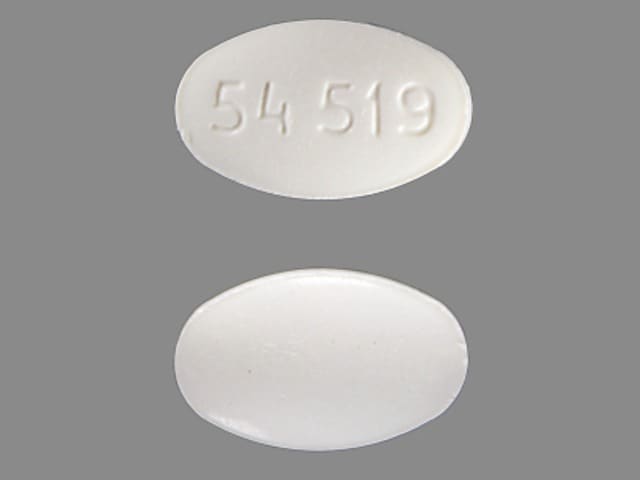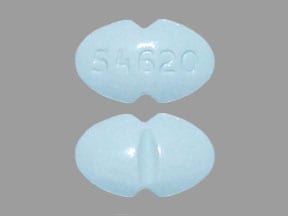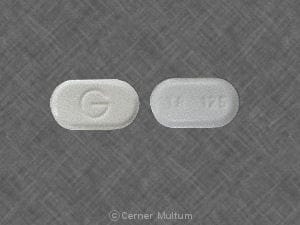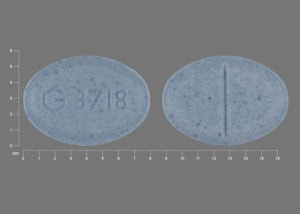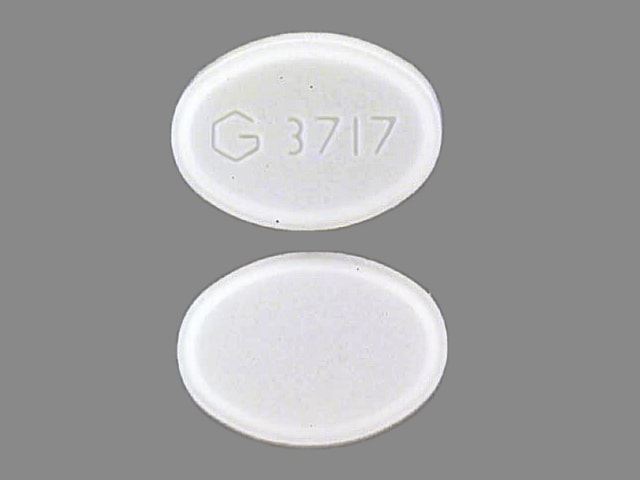Boxed Warning
Risks from concomitant use with opioids
Concomitant use of benzodiazepines and opioids may result in profound sedation, respiratory depression, coma, and death. Reserve concomitant prescribing of these drugs for use in patients for whom alternative treatment options are inadequate. Limit dosages and durations to the minimum required. Follow patients for signs and symptoms of respiratory depression and sedation.
Dosage Forms
Excipient information presented when available (limited, particularly for generics); consult specific product labeling.
Tablet, Oral:
Halcion: 0.25 mg [scored]
Generic: 0.125 mg, 0.25 mg
Pharmacology
Mechanism of Action
Binds to stereospecific benzodiazepine receptors on the postsynaptic GABA neuron at several sites within the central nervous system, including the limbic system and reticular formation. Enhancement of the inhibitory effect of GABA on neuronal excitability results by increased neuronal membrane permeability to chloride ions. This shift in chloride ions results in hyperpolarization (a less excitable state) and stabilization. Benzodiazepine receptors and effects appear to be linked to the GABA-A receptors. Benzodiazepines do not bind to GABA-B receptors (Vinkers 2012).
Pharmacokinetics/Pharmacodynamics
Distribution
Vd: 0.6 to 1.7 L/kg (Pakes 1981)
Metabolism
Extensively hepatic; hydroxylation via CYP3A4 (initial step in metabolism) with subsequent glucuronide conjugation to 6 metabolites, including a short-acting active metabolite, alpha-hydroxytriazolam (Pakes, 1981)
Excretion
Urine (~80% as metabolites; small amounts as unchanged drug)
Onset of Action
Hypnotic: 15 to 30 minutes (Pakes 1981)
Time to Peak
Oral: Within 2 hours
Duration of Action
Hypnotic: 6 to 7 hours
Half-Life Elimination
1.5 to 5.5 hours
Protein Binding
89% (Pakes, 1981)
Use in Specific Populations
Special Populations: Elderly
Cmax and AUC are increased; clearance is decreased (Greenblatt 1991)
Use: Labeled Indications
Insomnia: Short-term (generally 7 to 10 days) treatment of insomnia
Use: Off Label
Oral sedation prior to outpatient dental proceduresc
Data from a randomized, double-blind, placebo-controlled trial suggests the use of triazolam may be beneficial as oral sedation prior to outpatient dental procedures Berthold 1997. Clinical experience also suggests the utility of triazolam in this setting Dionne 2006.
Contraindications
Hypersensitivity to triazolam, other benzodiazepines, or any component of the formulation; concurrent therapy with strong cytochrome P450 3A (CYP 3A) inhibitors (eg, itraconazole, ketoconazole, nefazodone, lopinavir, ritonavir).
Dosage and Administration
Dosing: Adult
Insomnia (short-term use): Usual dose: 0.25 mg at bedtime; 0.125 mg at bedtime may be sufficient in some patients, such as those with low body weight; maximum dose: 0.5 mg/day.
Dental preprocedure oral sedation (off-label use): 0.25 mg 1 hour before procedure; 0.125 mg used for elderly patients or patients sensitive to sedative effects (Dionne 2006).
Dosing: Geriatric
Elderly and/or debilitated patients: Insomnia (short-term use): Oral: Initial: 0.125 mg at bedtime; maximum dose: 0.25 mg/day.
Dosing: Pediatric
Insomnia (short-term use): Adolescents ≥18 years: Oral: 0.125 to 0.25 mg at bedtime; the lower dose of 0.125 mg at bedtime may be sufficient in some patients, such as those with low body weight; maximum daily dose: 0.5 mg/day
Administration
Oral: Administer on an empty stomach; do not take with a meal or immediately after a meal. Onset of action is rapid; patient should take immediately before bedtime.
Storage
Store at 20°C to 25°C (68°F to 77°F).
Triazolam Images
Drug Interactions
Alcohol (Ethyl): CNS Depressants may enhance the CNS depressant effect of Alcohol (Ethyl). Monitor therapy
Alizapride: May enhance the CNS depressant effect of CNS Depressants. Monitor therapy
Azelastine (Nasal): CNS Depressants may enhance the CNS depressant effect of Azelastine (Nasal). Avoid combination
Blonanserin: CNS Depressants may enhance the CNS depressant effect of Blonanserin. Consider therapy modification
Bosentan: May decrease the serum concentration of CYP3A4 Substrates (High risk with Inducers). Monitor therapy
Brexanolone: CNS Depressants may enhance the CNS depressant effect of Brexanolone. Monitor therapy
Brimonidine (Topical): May enhance the CNS depressant effect of CNS Depressants. Monitor therapy
Bromopride: May enhance the CNS depressant effect of CNS Depressants. Monitor therapy
Bromperidol: May enhance the CNS depressant effect of CNS Depressants. Avoid combination
Buprenorphine: CNS Depressants may enhance the CNS depressant effect of Buprenorphine. Management: Consider reduced doses of other CNS depressants, and avoiding such drugs in patients at high risk of buprenorphine overuse/self-injection. Initiate buprenorphine at lower doses in patients already receiving CNS depressants. Consider therapy modification
Cannabidiol: May enhance the CNS depressant effect of CNS Depressants. Monitor therapy
Cannabis: May enhance the CNS depressant effect of CNS Depressants. Monitor therapy
Chlormethiazole: May enhance the CNS depressant effect of CNS Depressants. Management: Monitor closely for evidence of excessive CNS depression. The chlormethiazole labeling states that an appropriately reduced dose should be used if such a combination must be used. Consider therapy modification
Chlorphenesin Carbamate: May enhance the adverse/toxic effect of CNS Depressants. Monitor therapy
Clofazimine: May increase the serum concentration of CYP3A4 Substrates (High risk with Inhibitors). Monitor therapy
CloZAPine: Benzodiazepines may enhance the adverse/toxic effect of CloZAPine. Management: Consider decreasing the dose of (or possibly discontinuing) benzodiazepines prior to initiating clozapine. Consider therapy modification
CNS Depressants: May enhance the adverse/toxic effect of other CNS Depressants. Monitor therapy
Conivaptan: May increase the serum concentration of CYP3A4 Substrates (High risk with Inhibitors). Avoid combination
CYP3A4 Inducers (Moderate): May decrease the serum concentration of CYP3A4 Substrates (High risk with Inducers). Monitor therapy
CYP3A4 Inducers (Strong): May increase the metabolism of CYP3A4 Substrates (High risk with Inducers). Management: Consider an alternative for one of the interacting drugs. Some combinations may be specifically contraindicated. Consult appropriate manufacturer labeling. Consider therapy modification
CYP3A4 Inhibitors (Moderate): May increase the serum concentration of Triazolam. Management: Consider triazolam dose reduction in patients receiving concomitant moderate CYP3A4 inhibitors. Consider therapy modification
CYP3A4 Inhibitors (Strong): May increase the serum concentration of Triazolam. Avoid combination
CYP3A4 Inhibitors (Weak): May increase the serum concentration of Triazolam. Management: Consider triazolam dose reduction in patients receiving concomitant weak CYP3A4 inhibitors. Consider therapy modification
Dabrafenib: May decrease the serum concentration of CYP3A4 Substrates (High risk with Inducers). Management: Seek alternatives to the CYP3A4 substrate when possible. If concomitant therapy cannot be avoided, monitor clinical effects of the substrate closely (particularly therapeutic effects). Consider therapy modification
Deferasirox: May decrease the serum concentration of CYP3A4 Substrates (High risk with Inducers). Monitor therapy
DexAMETHasone (Systemic): May decrease the serum concentration of Triazolam. Monitor therapy
Dimethindene (Topical): May enhance the CNS depressant effect of CNS Depressants. Monitor therapy
Doxylamine: May enhance the CNS depressant effect of CNS Depressants. Management: The manufacturer of Diclegis (doxylamine/pyridoxine), intended for use in pregnancy, specifically states that use with other CNS depressants is not recommended. Monitor therapy
Dronabinol: May enhance the CNS depressant effect of CNS Depressants. Monitor therapy
Droperidol: May enhance the CNS depressant effect of CNS Depressants. Management: Consider dose reductions of droperidol or of other CNS agents (eg, opioids, barbiturates) with concomitant use. Exceptions to this monograph are discussed in further detail in separate drug interaction monographs. Consider therapy modification
Enzalutamide: May decrease the serum concentration of CYP3A4 Substrates (High risk with Inducers). Management: Concurrent use of enzalutamide with CYP3A4 substrates that have a narrow therapeutic index should be avoided. Use of enzalutamide and any other CYP3A4 substrate should be performed with caution and close monitoring. Consider therapy modification
Erdafitinib: May decrease the serum concentration of CYP3A4 Substrates (High risk with Inducers). Monitor therapy
Erdafitinib: May increase the serum concentration of CYP3A4 Substrates (High risk with Inhibitors). Monitor therapy
Esketamine: May enhance the CNS depressant effect of CNS Depressants. Monitor therapy
Flunitrazepam: CNS Depressants may enhance the CNS depressant effect of Flunitrazepam. Consider therapy modification
Fusidic Acid (Systemic): May increase the serum concentration of CYP3A4 Substrates (High risk with Inhibitors). Avoid combination
Hormonal Contraceptives: May increase the serum concentration of Triazolam. Monitor therapy
HYDROcodone: CNS Depressants may enhance the CNS depressant effect of HYDROcodone. Management: Avoid concomitant use of hydrocodone and benzodiazepines or other CNS depressants when possible. These agents should only be combined if alternative treatment options are inadequate. If combined, limit the dosages and duration of each drug. Consider therapy modification
HydrOXYzine: May enhance the CNS depressant effect of CNS Depressants. Monitor therapy
Idelalisib: May increase the serum concentration of CYP3A4 Substrates (High risk with Inhibitors). Avoid combination
Ivosidenib: May decrease the serum concentration of CYP3A4 Substrates (High risk with Inducers). Monitor therapy
Kava Kava: May enhance the adverse/toxic effect of CNS Depressants. Monitor therapy
Lemborexant: May enhance the CNS depressant effect of CNS Depressants. Management: Dosage adjustments of lemborexant and of concomitant CNS depressants may be necessary when administered together because of potentially additive CNS depressant effects. Close monitoring for CNS depressant effects is necessary. Consider therapy modification
Lofexidine: May enhance the CNS depressant effect of CNS Depressants. Management: Drugs listed as exceptions to this monograph are discussed in further detail in separate drug interaction monographs. Monitor therapy
Lorlatinib: May decrease the serum concentration of CYP3A4 Substrates (High risk with Inducers). Management: Avoid concurrent use of lorlatinib with any CYP3A4 substrates for which a minimal decrease in serum concentrations of the CYP3A4 substrate could lead to therapeutic failure and serious clinical consequences. Consider therapy modification
Lumacaftor and Ivacaftor: May decrease the serum concentration of Triazolam. Management: Consider alternatives to triazolam in patients treated with ivacaftor/lumacaftor due to the potential for decreased triazolam exposure and efficacy. Consider therapy modification
Magnesium Sulfate: May enhance the CNS depressant effect of CNS Depressants. Monitor therapy
Melatonin: May enhance the sedative effect of Benzodiazepines. Monitor therapy
Methadone: Benzodiazepines may enhance the CNS depressant effect of Methadone. Management: Clinicians should generally avoid concurrent use of methadone and benzodiazepines when possible; any combined use should be undertaken with extra caution. Consider therapy modification
Methotrimeprazine: CNS Depressants may enhance the CNS depressant effect of Methotrimeprazine. Methotrimeprazine may enhance the CNS depressant effect of CNS Depressants. Management: Reduce adult dose of CNS depressant agents by 50% with initiation of concomitant methotrimeprazine therapy. Further CNS depressant dosage adjustments should be initiated only after clinically effective methotrimeprazine dose is established. Consider therapy modification
MetyroSINE: CNS Depressants may enhance the sedative effect of MetyroSINE. Monitor therapy
Minocycline (Systemic): May enhance the CNS depressant effect of CNS Depressants. Monitor therapy
Mitotane: May decrease the serum concentration of CYP3A4 Substrates (High risk with Inducers). Management: Doses of CYP3A4 substrates may need to be adjusted substantially when used in patients being treated with mitotane. Consider therapy modification
Nabilone: May enhance the CNS depressant effect of CNS Depressants. Monitor therapy
OLANZapine: May enhance the adverse/toxic effect of Benzodiazepines. Management: Avoid concomitant use of parenteral benzodiazepines and IM olanzapine due to risks of additive adverse events (e.g., cardiorespiratory depression). Olanzapine prescribing information provides no specific recommendations regarding oral administration. Avoid combination
Opioid Agonists: CNS Depressants may enhance the CNS depressant effect of Opioid Agonists. Management: Avoid concomitant use of opioid agonists and benzodiazepines or other CNS depressants when possible. These agents should only be combined if alternative treatment options are inadequate. If combined, limit the dosages and duration of each drug. Consider therapy modification
Orphenadrine: CNS Depressants may enhance the CNS depressant effect of Orphenadrine. Avoid combination
Oxomemazine: May enhance the CNS depressant effect of CNS Depressants. Avoid combination
OxyCODONE: CNS Depressants may enhance the CNS depressant effect of OxyCODONE. Management: Avoid concomitant use of oxycodone and benzodiazepines or other CNS depressants when possible. These agents should only be combined if alternative treatment options are inadequate. If combined, limit the dosages and duration of each drug. Consider therapy modification
Paraldehyde: CNS Depressants may enhance the CNS depressant effect of Paraldehyde. Avoid combination
Perampanel: May enhance the CNS depressant effect of CNS Depressants. Management: Patients taking perampanel with any other drug that has CNS depressant activities should avoid complex and high-risk activities, particularly those such as driving that require alertness and coordination, until they have experience using the combination. Consider therapy modification
Piribedil: CNS Depressants may enhance the CNS depressant effect of Piribedil. Monitor therapy
Pramipexole: CNS Depressants may enhance the sedative effect of Pramipexole. Monitor therapy
RaNITIdine: May increase the serum concentration of Triazolam. Monitor therapy
ROPINIRole: CNS Depressants may enhance the sedative effect of ROPINIRole. Monitor therapy
Rotigotine: CNS Depressants may enhance the sedative effect of Rotigotine. Monitor therapy
Rufinamide: May enhance the adverse/toxic effect of CNS Depressants. Specifically, sleepiness and dizziness may be enhanced. Monitor therapy
Sarilumab: May decrease the serum concentration of CYP3A4 Substrates (High risk with Inducers). Monitor therapy
Selective Serotonin Reuptake Inhibitors: CNS Depressants may enhance the adverse/toxic effect of Selective Serotonin Reuptake Inhibitors. Specifically, the risk of psychomotor impairment may be enhanced. Monitor therapy
Siltuximab: May decrease the serum concentration of CYP3A4 Substrates (High risk with Inducers). Monitor therapy
Simeprevir: May increase the serum concentration of Triazolam. Monitor therapy
Sodium Oxybate: Benzodiazepines may enhance the CNS depressant effect of Sodium Oxybate. Avoid combination
Stiripentol: May increase the serum concentration of CYP3A4 Substrates (High risk with Inhibitors). Management: Use of stiripentol with CYP3A4 substrates that are considered to have a narrow therapeutic index should be avoided due to the increased risk for adverse effects and toxicity. Any CYP3A4 substrate used with stiripentol requires closer monitoring. Consider therapy modification
Suvorexant: CNS Depressants may enhance the CNS depressant effect of Suvorexant. Management: Dose reduction of suvorexant and/or any other CNS depressant may be necessary. Use of suvorexant with alcohol is not recommended, and the use of suvorexant with any other drug to treat insomnia is not recommended. Consider therapy modification
Tapentadol: May enhance the CNS depressant effect of CNS Depressants. Management: Avoid concomitant use of tapentadol and benzodiazepines or other CNS depressants when possible. These agents should only be combined if alternative treatment options are inadequate. If combined, limit the dosages and duration of each drug. Consider therapy modification
Teduglutide: May increase the serum concentration of Benzodiazepines. Monitor therapy
Tetrahydrocannabinol: May enhance the CNS depressant effect of CNS Depressants. Monitor therapy
Tetrahydrocannabinol and Cannabidiol: May enhance the CNS depressant effect of CNS Depressants. Monitor therapy
Thalidomide: CNS Depressants may enhance the CNS depressant effect of Thalidomide. Avoid combination
Theophylline Derivatives: May diminish the therapeutic effect of Benzodiazepines. Consider therapy modification
Tocilizumab: May decrease the serum concentration of CYP3A4 Substrates (High risk with Inducers). Monitor therapy
Trimeprazine: May enhance the CNS depressant effect of CNS Depressants. Monitor therapy
Yohimbine: May diminish the therapeutic effect of Antianxiety Agents. Monitor therapy
Zolpidem: CNS Depressants may enhance the CNS depressant effect of Zolpidem. Management: Reduce the Intermezzo brand sublingual zolpidem adult dose to 1.75 mg for men who are also receiving other CNS depressants. No such dose change is recommended for women. Avoid use with other CNS depressants at bedtime; avoid use with alcohol. Consider therapy modification
Adverse Reactions
>10%: Central nervous system: Drowsiness (14%)
1% to 10%:
Central nervous system: Headache (10%), dizziness (5% to 8%), ataxia (5%), nervousness (5%)
Gastrointestinal: Nausea (5%), vomiting (5%)
<1%, postmarketing, and/or case reports: Abnormal dreams, anaphylaxis, angioedema, anterograde amnesia, sleep disorder (complex sleep-related behavior including cooking or eating food while asleep, making phone calls while asleep, sleep driving), confusion, depression, dermatitis, dysesthesia, euphoria, fatigue, hepatic failure (fulminant), memory impairment, muscle cramps, nightmares, pain, paresthesia, tachycardia, violent behavior, visual disturbance, weakness, xerostomia
Warnings/Precautions
Concerns related to adverse effects:
- Amnesia: Benzodiazepines have been associated with anterograde amnesia (Nelson 1999). Traveler's amnesia (if taken to induce sleep while traveling) due to insufficient time for sleep prior to awakening and initiating activity has also been reported.
- CNS depression: May cause CNS depression, which may impair physical or mental abilities; patients must be cautioned about performing tasks which require mental alertness (eg, operating machinery or driving).
- Hypersensitivity reactions: Reports of hypersensitivity reactions, including anaphylaxis and angioedema, have been reported with triazolam. Patients who develop angioedema should not be rechallenged with triazolam.
- Paradoxical reactions: Paradoxical reactions, including hyperactive or aggressive behavior, have been reported with benzodiazepines; risk may be increased in adolescent/pediatric patients, geriatric patients, or patients with a history of alcohol use disorder or psychiatric/personality disorders (Mancuso 2004).
- Sleep-related activities: Hazardous sleep-related activities such as sleep-driving, cooking and eating food, and making phone calls while asleep have been noted with benzodiazepines (Dolder 2008).
Disease-related concerns:
- Depression: Use caution in patients with depression, particularly if suicidal risk may be present. Minimize risks of overdose by prescribing the least amount of drug that is feasible in suicidal patients. Worsening of depressive symptoms has also been reported with use of benzodiazepines.
- Drug abuse: Use with caution in patients with a history of drug abuse or acute alcoholism; potential for drug dependency exists. Tolerance, psychological and physical dependence may occur with prolonged use.
- Hepatic impairment: Use with caution in patients with hepatic impairment; undergoes extensive hepatic metabolism.
- Renal impairment: Use with caution in patients with renal impairment.
- Respiratory disease: Use with caution in patients with respiratory compromise, COPD, or sleep apnea.
Concurrent drug therapy issues:
- Concomitant use with opioids: [US Boxed warning]: Concomitant use of benzodiazepines and opioids may result in profound sedation, respiratory depression, coma, and death. Reserve concomitant prescribing of these drugs for use in patients for whom alternative treatment options are inadequate. Limit dosages and durations to the minimum required. Follow patients for signs and symptoms of respiratory depression and sedation.
- Drug-drug interactions: Potentially significant interactions may exist, requiring dose or frequency adjustment, additional monitoring, and/or selection of alternative therapy. Consult drug interactions database for more detailed information.
Special populations:
- Debilitated patients: Use with caution in debilitated patients; potential for oversedation, impaired coordination, and dizziness with use.
- Elderly: Elderly patients experience greater sedation and increased psychomotor impairment (Greenblatt 1991). Elderly patients may be at an increased risk of death with use; risk has been found highest within the first 4 months of use in elderly dementia patients (Jennum 2015; Saarelainen 2018).
- Fall risk: Use with extreme caution in patients who are at risk of falls; benzodiazepines have been associated with falls and traumatic injury (Nelson 1999).
Other warnings/precautions:
- Appropriate use: Does not have analgesic, antidepressant, or antipsychotic properties. Should be used only after evaluation of potential causes of sleep disturbance. Failure of sleep disturbance to resolve after 7 to 10 days may indicate psychiatric or medical illness. Use for >21 days requires complete reevaluation of patient. A worsening of insomnia or the emergence of new abnormalities of thought or behavior may represent unrecognized psychiatric or medical illness and requires immediate and careful evaluation. Prescription should be written for a maximum of 7 to 10 days and should not be prescribed in quantities exceeding a 1-month supply. Use lowest effective dose; adverse reactions of triazolam are dose related.
- Tolerance: Triazolam is a short half-life benzodiazepine. Duration of action after a single dose is determined by redistribution rather than metabolism. Tolerance develops to the hypnotic effects (Vinkers 2012). Chronic use of this agent may increase the perioperative benzodiazepine dose needed to achieve desired effect.
- Withdrawal: Rebound insomnia or withdrawal symptoms may occur following abrupt discontinuation or large decreases in dose. Use caution when reducing dose or withdrawing therapy; decrease slowly and monitor for withdrawal symptoms. Flumazenil may cause withdrawal in patients receiving long-term benzodiazepine therapy. An increase in daytime anxiety may occur after as few as 10 days of continuous use, which may be related to withdrawal reaction in some patients.
Monitoring Parameters
Respiratory rate.
Pregnancy
Pregnancy Considerations
A case report describes placental transfer of triazolam following a maternal overdose (Sakai 1996).
Teratogenic effects have been observed with some benzodiazepines; however, additional studies are needed. The incidence of premature birth and low birth weights may be increased following maternal use of benzodiazepines; hypoglycemia and respiratory problems in the neonate may occur following exposure late in pregnancy. Neonatal withdrawal symptoms may occur within days to weeks after birth and “floppy infant syndrome” (which also includes withdrawal symptoms) have been reported with some benzodiazepines (Bergman 1992; Iqbal 2002; Wikner 2007). Infants exposed to triazolam during pregnancy should be monitored for respiratory depression, sedation, withdrawal, or feeding problems.
Data collection to monitor pregnancy and infant outcomes following exposure to triazolam is ongoing. Health care providers are encouraged to enroll females exposed to triazolam during pregnancy in the National Pregnancy Registry for Other Psychiatric Medications (866-961-2388 or https://womensmentalhealth.org/research/pregnancyregistry/othermedications/).
Patient Education
What is this drug used for?
- It is used to treat sleep problems.
Frequently reported side effects of this drug
- Headache
- Loss of strength and energy
- Fatigue the next day
Other side effects of this drug: Talk with your doctor right away if you have any of these signs of:
- Depression like thoughts of suicide, anxiety, agitation, irritability, panic attacks, mood changes, behavioral changes, or confusion
- Behavioral changes
- Mood changes
- Anxiety
- Sensing things that seem real but are not
- Trouble with memory
- Severe dizziness
- Passing out
- Change in balance
- Confusion
- Trouble thinking clearly
- Signs of a significant reaction like wheezing; chest tightness; fever; itching; bad cough; blue skin color; seizures; or swelling of face, lips, tongue, or throat.
Note: This is not a comprehensive list of all side effects. Talk to your doctor if you have questions.
Consumer Information Use and Disclaimer: This information should not be used to decide whether or not to take this medicine or any other medicine. Only the healthcare provider has the knowledge and training to decide which medicines are right for a specific patient. This information does not endorse any medicine as safe, effective, or approved for treating any patient or health condition. This is only a brief summary of general information about this medicine. It does NOT include all information about the possible uses, directions, warnings, precautions, interactions, adverse effects, or risks that may apply to this medicine. This information is not specific medical advice and does not replace information you receive from the healthcare provider. You must talk with the healthcare provider for complete information about the risks and benefits of using this medicine.

